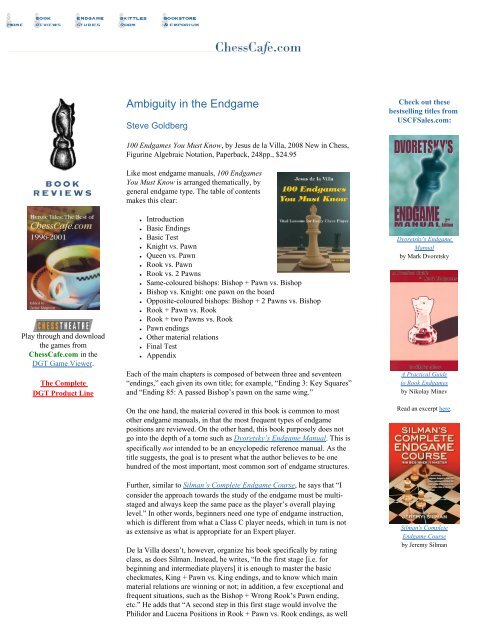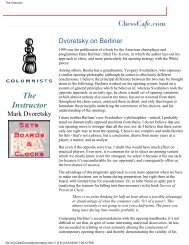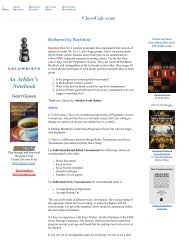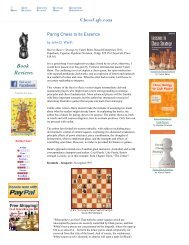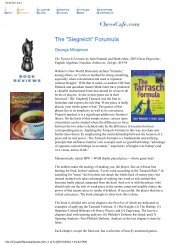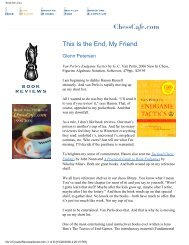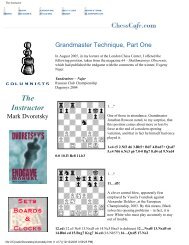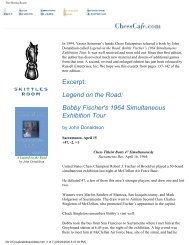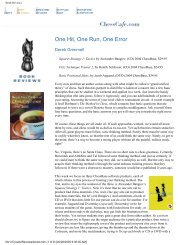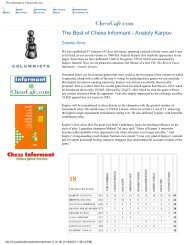100 Endgames You Must Know - Chess Cafe
100 Endgames You Must Know - Chess Cafe
100 Endgames You Must Know - Chess Cafe
You also want an ePaper? Increase the reach of your titles
YUMPU automatically turns print PDFs into web optimized ePapers that Google loves.
Play through and download<br />
the games from<br />
<strong>Chess</strong><strong>Cafe</strong>.com in the<br />
DGT Game Viewer.<br />
The Complete<br />
DGT Product Line<br />
Ambiguity in the Endgame<br />
Steve Goldberg<br />
<strong>100</strong> <strong>Endgames</strong> <strong>You</strong> <strong>Must</strong> <strong>Know</strong>, by Jesus de la Villa, 2008 New in <strong>Chess</strong>,<br />
Figurine Algebraic Notation, Paperback, 248pp., $24.95<br />
Like most endgame manuals, <strong>100</strong> <strong>Endgames</strong><br />
<strong>You</strong> <strong>Must</strong> <strong>Know</strong> is arranged thematically, by<br />
general endgame type. The table of contents<br />
makes this clear:<br />
● Introduction<br />
● Basic Endings<br />
● Basic Test<br />
● Knight vs. Pawn<br />
● Queen vs. Pawn<br />
● Rook vs. Pawn<br />
● Rook vs. 2 Pawns<br />
● Same-coloured bishops: Bishop + Pawn vs. Bishop<br />
● Bishop vs. Knight: one pawn on the board<br />
● Opposite-coloured bishops: Bishop + 2 Pawns vs. Bishop<br />
● Rook + Pawn vs. Rook<br />
● Rook + two Pawns vs. Rook<br />
● Pawn endings<br />
● Other material relations<br />
● Final Test<br />
● Appendix<br />
Each of the main chapters is composed of between three and seventeen<br />
“endings,” each given its own title; for example, “Ending 3: Key Squares”<br />
and “Ending 85: A passed Bishop’s pawn on the same wing.”<br />
On the one hand, the material covered in this book is common to most<br />
other endgame manuals, in that the most frequent types of endgame<br />
positions are reviewed. On the other hand, this book purposely does not<br />
go into the depth of a tome such as Dvoretsky’s Endgame Manual. This is<br />
specifically not intended to be an encyclopedic reference manual. As the<br />
title suggests, the goal is to present what the author believes to be one<br />
hundred of the most important, most common sort of endgame structures.<br />
Further, similar to Silman’s Complete Endgame Course, he says that “I<br />
consider the approach towards the study of the endgame must be multistaged<br />
and always keep the same pace as the player’s overall playing<br />
level.” In other words, beginners need one type of endgame instruction,<br />
which is different from what a Class C player needs, which in turn is not<br />
as extensive as what is appropriate for an Expert player.<br />
De la Villa doesn’t, however, organize his book specifically by rating<br />
class, as does Silman. Instead, he writes, “In the first stage [i.e. for<br />
beginning and intermediate players] it is enough to master the basic<br />
checkmates, King + Pawn vs. King endings, and to know which main<br />
material relations are winning or not; in addition, a few exceptional and<br />
frequent situations, such as the Bishop + Wrong Rook’s Pawn ending,<br />
etc.” He adds that “A second step in this first stage would involve the<br />
Philidor and Lucena Positions in Rook + Pawn vs. Rook endings, as well<br />
Check out these<br />
bestselling titles from<br />
USCFSales.com:<br />
Dvoretsky's Endgame<br />
Manual<br />
by Mark Dvoretsky<br />
A Practical Guide<br />
to Rook <strong>Endgames</strong><br />
by Nikolay Minev<br />
Read an excerpt here.<br />
Silman's Complete<br />
Endgame Course<br />
by Jeremy Silman
as some more ideas in pawn endings and opposite-coloured bishop<br />
endings.” The author then notes that this material is covered in Chapter 1<br />
(consisting of nine endgame positions), and fourteen other specific<br />
endings from other chapters.<br />
While the endings selected are indeed helpful as a “first stage” of<br />
endgame understanding, the Philidor and Lucena Positions are nowhere to<br />
be found among these twenty-three endgames, despite the author having<br />
noted their importance. Presumably, Ending 52 (Philidor) and Ending 53<br />
(Lucena) were intended to be included in the list of required study<br />
positions.<br />
In the author’s opinion, mastering this “first stage” material is attainable<br />
for any player willing to put in a little effort, and is sufficient for players<br />
up to about a 1900-2000 FIDE rating. At this point, de la Villa states,<br />
“We should move to the second phase,” which involves acquiring “an<br />
exact knowledge of some theoretical endings…They are just a few, but<br />
you must know them well. This fundamental knowledge and the<br />
confidence we acquire with it is the starting point to study other positions<br />
of greater complexity or to turn a technical advantage into victory.”<br />
It is for this “second phase” that the bulk of this book was written,<br />
roughly for players rated between 2000 and 2400.<br />
The author provides an interesting statistical analysis that I had not<br />
encountered before. Using a database of approximately four million<br />
games, he breaks down games by various endgame criteria. For example,<br />
he found that about eight percent of games ended with one rook for each<br />
side, any number of pawns, but no other pieces. About thirty-eight<br />
perecnt of these rook endings concluded in a draw, belying the commonly<br />
stated opinion that “all rook endings are drawn.”<br />
In this same statistical analysis, he found that approximately three percent<br />
of all games ended with only pawns left, no other pieces, with about<br />
twenty-seven percent of these games ending in draws. Other interesting<br />
findings he identifies are<br />
● about fifty-four percent of the time, R+P vs. R endings were drawn<br />
● with R+2P vs. R, draws fell to just under twenty percent<br />
● B+P vs. B, with opposite-colored bishops, were drawn ninety<br />
percent of the time, although the<br />
● number of such games was quite small<br />
● B+P vs. B, with same-colored bishops, about fifty-three percent<br />
were drawn<br />
One statistic I found surprising was that a B+N vs. K ending occurred a<br />
total of 712 times in his database. This represents a very small percentage<br />
of games, but still the number was higher than I would have imagined.<br />
Even more surprising, nearly nineteen percent of these games ended in<br />
draws! The B+N vs. K is a forced win, yet about a fifth of the time, the<br />
winning side couldn’t produce the victory.<br />
Anyone with <strong>Chess</strong>Base and a large database can run a similar analysis,<br />
and my own testing was closely in line with de la Villa’s results. Besides<br />
providing some interesting numbers, the point of this analysis is to<br />
demonstrate the draw-likelihood for a wide variety of endgame situations.<br />
As the author rightly points out, “If you neglect this part of the game,<br />
many half points, or even full points, will now and then elude you.”<br />
For example, let’s look at “Ending 81: Pawns on adjacent files:”<br />
“When the pawns are on adjacent files, it<br />
is quite easy to calculate the<br />
consequences of the capture or the<br />
defence of the pawns. <strong>You</strong> just need to<br />
know one interesting resource. Here the
white pawn is lost and, when the black<br />
king captures it, he will occupy one of<br />
the key squares, thus promoting. Can<br />
White be saved? 1.e5! Yes!!! By means<br />
of this pawn sacrifice, White manages to<br />
change the key squares: now, instead of<br />
e4, f4 and g4, the key squares are d3, e3 and f3, and the black king cannot<br />
reach them. 1…fxe5 2.Kg2 Kf4 3.Kf2 Now the black king is unable to<br />
occupy the key squares, therefore the ending is drawn.”<br />
In reviewing the “Basic Endings” from chapter one, it is apparent that this<br />
material is not really for beginners, as not enough simple explanations are<br />
given, but it is probably suitable for intermediate players (i.e. about 1400-<br />
1800) who may need a refresher about some of these basic positions. I did<br />
find his presentation of key squares (Ending 3) to be straightforward and<br />
clear.<br />
In some cases, though, explanations aren’t entirely clear. Despite an<br />
abundance of diagrams, at least for this reviewer, a little fog often<br />
remained.<br />
For example, in “Ending 74: Blocked connected pawns,” de la Villa does<br />
an excellent job of explaining how a king and rook may be able to draw<br />
against a king and rook and two connected passed pawns, in the following<br />
position:<br />
1.Rd4 Rb6 2.Rd8! Rb4+ 3.Ke5 Rb7! 4.<br />
Rg8+ Kh7 5.Re8 Kg6 6.Kf4 Rb4+ 7.<br />
Ke5 Rb7=<br />
But then the author notes that if the<br />
pawns are both moved one file to the<br />
left, “White can break the blockade:”<br />
“Here White can force a winning pawn<br />
endgame. 1.Re4 Rb6 2.Re6+! Quite<br />
simple. <strong>You</strong> just have to take into<br />
account the position of your king (for<br />
instance, if the king were on g4 the<br />
ending would be drawn). 2…Rxe6 3.<br />
fxe6 Kxe6 4.Kg5 +–”<br />
My confusion here is with the comment<br />
“if the king were on g4 the ending would<br />
be drawn.” Why? No explanation is<br />
given. Let’s take a quick look at the hypothetical position, with the white<br />
king on g4:<br />
I think the author meant that Black<br />
draws with 1.Re4 Rb6 2.Re6+ Rxe6 3.<br />
fxe6 Kxg6, which is indeed a draw.<br />
However, if White plays 2.Kf4 instead<br />
of 2.Re6+, he wins, as above.<br />
Another confusing case occurs in the<br />
author’s Queen vs. Pawn chapter. The<br />
following position is presented:
De la Villa notes that this is a drawn<br />
position, but points out an interesting<br />
trick that Black needs to beware of: 1.<br />
Qb3+ Ka1! 2.Qe3 Kb1 3.Qe4 Kb2 4.<br />
Qe2<br />
The author notes that the natural-looking<br />
4…Kb1?? loses to 5.Kc4! c1Q+ 6.Kb3,<br />
when Black cannot avoid checkmate.<br />
This part I found instructive, but then the<br />
main line continues 4…Ka1! 5.Kc4 c1Q<br />
+ 6.Kb3 Qb1+, producing the following<br />
position:<br />
And this variation concludes with the<br />
comment, “Only move, but not enough<br />
to draw.” But how does White win here?<br />
It sure seems like a dead draw to me, but<br />
not trusting my own analysis, I asked for<br />
a second opinion from Fritz, which<br />
quickly confirmed – dead draw. Perhaps<br />
what was intended was “Only move, but<br />
enough to draw.”<br />
There were a few such instances in which I wasn’t quite certain what de<br />
la Villa intended, or I didn’t understand his explanation, but nevertheless,<br />
I found most of the book quite informative and helpful.<br />
One short example of a helpful tactic to be aware of appears at the end of<br />
“Ending 92: Breakthroughs when the king is far:”<br />
“This is an interesting position, as the<br />
two white pawns look harmless and we<br />
can learn a new technique here.<br />
Sometimes the breakthrough is more<br />
efficient if we first push the pawn which<br />
has an enemy pawn opposed. This<br />
apparently harmless couple of pawns has<br />
caught out many players, among them<br />
Capablanca. 1.h6! and White wins. The<br />
king will not be able to stop the wouldbe<br />
passed h-pawn: 1…Ke6 2.g6 +–”<br />
So I’m left with mixed feelings about the book. There really is much to<br />
like about it. It is organized in a sensible thematic structure, and many of<br />
de la Villa’s explanations are quite clear, and most of his endings offer a<br />
brief “Conclusion” highlighting the main point(s) to be learned from the<br />
section. Conversely, I found that too often, I had to re-read a portion to<br />
understand what he intended to get across. Sometimes it’s just a matter of<br />
the material being so complex that this is required, which is normal. But<br />
on a number of occasions, there was enough ambiguity that I was unclear<br />
exactly what the author was saying.<br />
These are problems I didn’t encounter in Practical Endgame Play –<br />
Mastering the Basics, or in Silman’s Complete Endgame Course, either of<br />
which are excellent resources for intermediate players looking for a
similar thematic structure. Perhaps the 2000+ player for which <strong>100</strong><br />
<strong>Endgames</strong> <strong>You</strong> <strong>Must</strong> <strong>Know</strong> is really intended will not find the same<br />
ambiguities as I did, but I would have given this book a complete<br />
“thumbs up” were it not for this one issue.<br />
Order <strong>100</strong> <strong>Endgames</strong> <strong>You</strong> <strong>Must</strong> <strong>Know</strong><br />
by Jesus de la Villa<br />
[<strong>Chess</strong><strong>Cafe</strong> Home Page] [Book Review] [Columnists]<br />
[Endgame Study] [The Skittles Room] [Archives]<br />
[Links] [Online Bookstore] [About <strong>Chess</strong><strong>Cafe</strong>.com] [Contact Us]<br />
© 2008 Cyber<strong>Cafe</strong>s, LLC. All Rights Reserved.<br />
"<strong>Chess</strong><strong>Cafe</strong>.com ®" is a registered trademark of Russell Enterprises, Inc.


